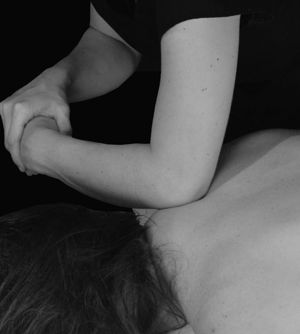- Home
- Western Massage
- Deep Tissue
As an affiliate for Bookshop, Amazon, and other programs, I may earn a small commission for products purchased through links. This doesn't affect the price you pay. Privacy policy and disclosures.
Search this site:
What Is Deep Tissue Massage Therapy
and Its Benefits?
The goal of deep tissue massage therapy is to release tension in deeper muscles and loosen stuck-together individual muscle fibers (adhesions) that interfere with muscle movement. Massage therapists often use their elbows, forearms, and knuckles to apply deep pressure.
What Is Deep Tissue Massage?
The meaning of deep tissue massage varies, as it's a somewhat generic term. There are many ways of doing deep massage. A common myth is that this type of massage has to be painful. IT DOES NOT!
Skilled deep tissue is about working with a person's body to reach
deeper levels, not plowing through tissue no matter what. Sometimes it
can be uncomfortable or intense, depending on your body's condition, but a
good massage shouldn't cause a lot of pain. Intense pain usually indicates the massage therapist is trying to make something happen
rather than encouraging and letting it happen.
Deep tissue expert Art Riggs wrote in a 2005 article in Massage & Bodywork
that "painful work is usually ineffective because the muscles contract
against the pain, instead of lengthening and relaxing." According to
Riggs, the key to effective deep massage is slow strokes with specific intention and purpose backed by the full attention of the massage therapist.
Benefits of Deep Tissue Massage
Deep tissue massage therapy, sometimes called deep muscle massage, is especially effective for:
- Helping correct posture
- Improving limited mobility due to muscle problems
- Helping heal injuries, including whiplash, sports injuries, and repetitive strain problems.
Deep massage also offers the benefits of other types of massage, including relieving muscle tension and stress, improving sleep, reducing pain and stiffness, and improving mood.
Deep Tissue Massage Techniques
Although some deep massage therapy techniques resemble Swedish massage, the intention is different. Three of the most common deep tissue techniques are:
- Longitudinal lengthening strokes work in the direction of the muscle fibers and emphasize releasing the muscle, mobilizing tissue, and improving joint function.
- Anchor and stretch (also called pin and stretch) strokes focus on releasing an isolated segment of a muscle that has become short and fibrous. Typically, the massage therapist applies pressure to one point on the muscle, holding it in place, while also stretching the muscle.
- Cross-fiber strokes work across muscle fibers. The purpose is often to separate fibers that are stuck together. A variation on cross-fiber is a technique where the massage therapist grabs the tissue and rolls it.
In his book, Deep Tissue Massage: A Visual Guide to Techniques, Riggs offers the following principles to massage therapists:
- Never strain.
- Use little oil.
- Work slowly.
- Use oblique pressure.
- Work the tendons of muscles in addition to the belly of muscles.
- Have a clear intention of what you want to accomplish.
- Direct attention to the layer of the body at which you want to work.
- Let the body react and stabilize before moving on.
- Use proper body mechanics. Avoid using your thumbs.
What Is Deep Tissue Massage Video

For deep tissue massage with feet, see ashiatsu.
Pfrimmer Deep Muscle Therapy
Pfrimmer Deep Muscle Therapy is a specific type of deep muscle massage developed starting in the 1940s by Therese C. Pfrimmer of Canada. After being told by doctors that her paralyzed legs would probably never work again, Pfrimmer, who was trained in massage, began using deep massage techniques on herself and walked three months later.
For the next two years she used her techniques on an almost completely paralyzed woman who had advanced multiple sclerosis. The woman regained her ability to walk and went on to live for another 29 years, according to a Massage Magazine article by Barbara J. Mancini.
Pfrimmer believed her techniques worked by releasing adhered fibers and improving circulation in the muscles. Pfrimmer Deep Muscle Therapy is a system of cross-fiber strokes done in a detailed, systematic way that includes repeating a specific sequence of strokes on each muscle group. The first sequence starts the corrective process, while the repeat sequences prompt the natural healing process of the body.
Although officially Pfrimmer isn't considered a type of massage and can be learned by other trained healthcare professionals, in practice trained massage therapists most often learn and offer the technique. For more information, see the Therese C. Pfrimmer International Association of Pfrimmer Deep Muscle Therapy.
Sources and Books
Art Riggs, "Deep Tissue Massage Part 1- The Tools," Massage & Bodywork, February/March 2005. "Part 2 - Stroke Intention," Massage & Bodywork, April/May 2005. "Part 3 - Body Positioning," Massage & Bodywork, June/July 2005.
Barbara J. Mancini, "Pfrimmer Deep Muscle Therapy," Massage Magazine, July/August 1998.
Deep Tissue Massage, Revised Edition: A Visual Guide to Techniques
by Art Riggs
Deep Tissue Massage (Hands-On Guides for Therapists) by Jane Johnson
Buy essential oils: Aromatics International or Rocky Mountain Essential Oils.

